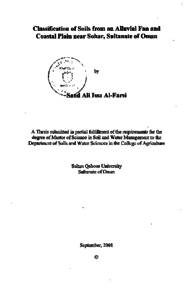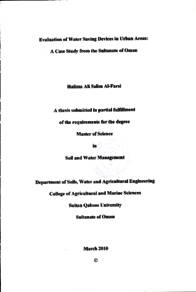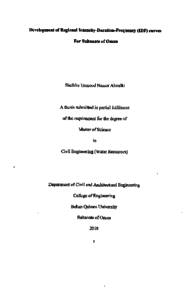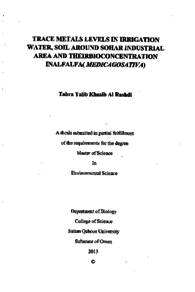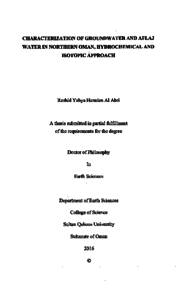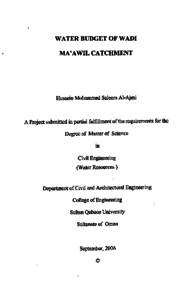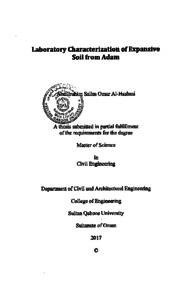Document
Classification of soils from an alluvial fan and Coastal Plain near Sohar, Sultanate of Oman
Gregorian
2001
Language
English
Subject
English abstract
Continued agricultural expansion in the Batinah Region of Oman is constrained by water scarcity and a decline in soil quality. The aim of this study was to investigate the properties currently being used to classify soils in Oman and propose possible alternatives.
Twelve soil pedons situated along two transects near Sohar in the Batinah Region of Oman were described and classified according to Soil Survey Staff (1999). The two transects were selected to encompass soils of the outer fringe of an alluvial fan and those of the coastal plains. One transect sampled soils adjacent to a main wadi channel, and second transect extended from upstream to downstream straggling the alluvial fan/coastal plain interaction zone. Pedons were described to a depth of at least 150 cm. Soil samples were collected from each identified horizon. Samples were analyzed for particle size distribution, salinity, pH, calcium carbonate and organic carbon (C) contents. Interrelationships between soil properties were assessed statistically using correlation analysis. Upstream soils consisted of coarse material overlying gravelly deposits, whereas those downstream were dominated by fine loamy material. Soils were mostly calcareous, non-saline upstream and saline near the coast.
Soils, in the study area, were classified either as Entisols or Aridisols, belonging to the following taxa: Typic Torriorthents, Typic Torripsamments, Typic Torrifluvents, Typic Haplogypsids, and Typic Aquisalids. In view of the low content and erratic distribution of soil organic C with depth, it is recommended the classification of Entisols should apply an alternative gravel and texture criteria. When classifying Aridisols, it was found important to have a consistent definition for the salic horizon related to local agricultural practices.
Member of
Resource URL
Arabic abstract
بالرغم من أن سلطنة عمان بحاجة إلى زيادة المساحات الزراعية في منطقة الباطنة . إلا أن هذه الزيادة تواجه عدة معوقات , منها ندرة المياه الصالحة للري , وقلة جودة التربة كلما اتجهنا باتجاه الجبال. ولهذا فإن مقيمي ومخططي الأراضي الزراعية بحاجة إلى معلومات عن التربة الموجودة في تلك المناطق التي يشملها أي توسع في المساحات الزراعية. ويمكن إستخلاص معظم هذه المعلومات من أسماء أو تصنيف التربة. وحيث أن تصنيف التربة يمكن أن يساعد في إيجاد خصائص وعلاقة تلك الترب ببعضها البعض في الحقل ويمكن تحقيق ذلك من خلال مسح التربة , وتصنيفها ورسم الخرائط الخاصة بها. كان لا بد من اختيار نظام التصنيف الملائم لكي يمكن توصیف و تقييم الأراضي الزراعية بالشكل الصحيح والمناسب. لها فأن الهدف الرئيسي من هذه الدراسة كان البحث في النظام المستخدم في تصنيف التربة في السلطنة وخاصة منطقة الباطنة. وإيجاد البدائل المناسبة التي تناسب نصنيف الأراضي بالسلطنة.
Category
Theses and Dissertations

